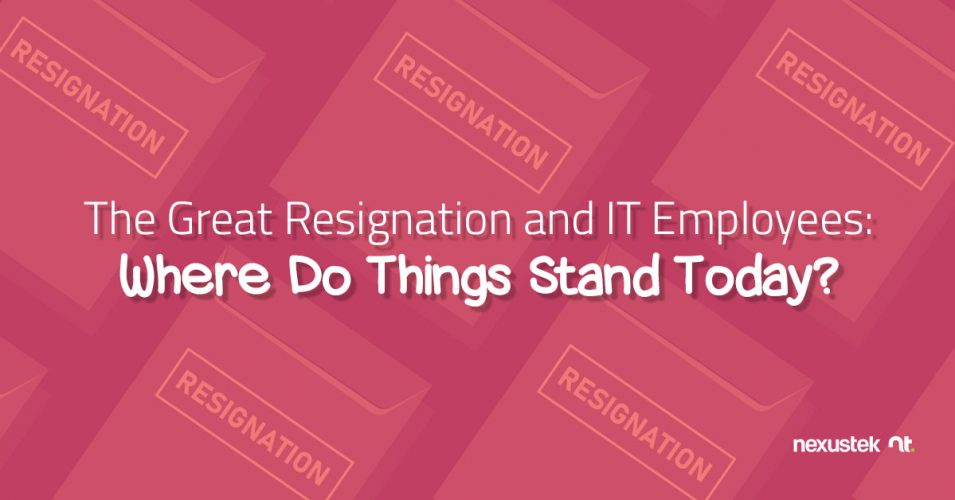READ TIME: 5 MIN

The Great Resignation and IT Employees: Where Do Things Stand Today?
April 2021 marked the onset of the Great Resignation when a record-setting 3.99 million U.S. workers voluntarily left their jobs1. Over a year later, many are wondering about the status of the Great Resignation. Is it over yet? Still continuing? We were interested in these questions as well—especially as they apply to IT employees—and the following is an overview of the situation we face today.
Status of the Great Resignation in 2022
Although many were shocked at the record-setting quit level of 3.99 million in April 2021, the ensuing monthly tallies of voluntary resignations reported by the Bureau of Labor Statistics (BLS) suggest that this was just the beginning. The number of monthly resignations has continued to climb, reaching a new record high of 4.51 million in November 20212.
Since the beginning of the Great Resignation, the average number of job quits has been 4.15 million per month, and in fact, the number of resignations per month has not fallen below 4 million since August of 2021. The most recent statistics from BLS show that 4.35 million workers left their jobs voluntarily in February 2022, indicating that the Great Resignation has not abated3.
Technology Employees and the Great Resignation
With a history of higher-than-average turnover that spans many years, the technology industry has been hit especially hard by the Great Resignation. To provide context, turnover rates for the technology industry in 2018 were the highest among all industries, at 13.2%4. More recently, in 2020, technology employee turnover rates were clocked at 21.3%5.
Data collected on turnover intentions during the Great Resignation suggest that turnover rates for technology professionals may only continue to climb in coming months. Survey data collected in September 2021 suggested that a full 72% of technology employees in the U.S. planned to quit their jobs in the next 12 months6.
The adverse effects of IT staff turnover are multifold. Losing members of your IT team can result in remaining team members feeling overworked and stressed, which can itself exacerbate turnover. Furthermore, losing IT knowledge and expertise can have a direct impact on the management and upkeep of your company’s IT systems. And of course, turnover in IT is expensive. A conservative estimate is that the cost of replacing an employee is about 30% of their salary7. This means that an IT employee who earns $90,000 per year costs approximately $27,000 to replace.
The Increasingly Important Role of Retention Strategies
The ongoing costs and challenges of high turnover have brought retention strategies into the spotlight. The high demand for talent in general—and IT employees specifically—translates to an employment market where job seekers are free to be choosy about which offers they accept. The abundance of demand places IT workers in a situation where, if they are unsatisfied with their current jobs, they have plenty of other options to consider.
For companies that wish to retain IT employees to the greatest extent possible, the questions then become: Why do IT workers quit, and what might entice them to stay? Research indicates that the most common causes of IT staff turnover are8:
- Seeking better pay
- Looking for better working conditions
- Desire for more responsibility
- Seeking opportunity to express creativity
Previous studies of turnover and retention in IT affirm these findings, demonstrating that factors like stress due to excessive workload and lack of professional development opportunities can send your best IT talent looking for greener pastures elsewhere9.
Managed IT Services as a Strategy for Curtailing High IT Turnover
Retooling your IT retention strategies is certainly a timely idea, and an option that you might not have considered is outsourcing a portion of your IT management to a managed services provider (MSP). By partnering with an MSP, you can:
- Decrease stress and burnout in your in-house IT team: Co-managing your IT systems with an MSP allows you to outsource the time-consuming and urgent tech support requests that make for long, stressful days for your IT team. When your employees can call the MSP’s help desk for support whenever they need it, this relieves the pressure that often drives in-house IT talent out the door.
- Give in-house IT staff opportunities for higher-value activities: Another benefit of co-managing your IT with an MSP is that, with the day-to-day tech support calls taken off your in-house IT team’s hands, they have more time for strategic IT activities. Not only does this provide your IT staff with more responsibility and opportunities for growth, but it also improves your company’s ability to achieve business goals by more effectively leveraging technologies.
Co-managing your IT in partnership with an MSP allows you to create working conditions that better meet the needs and expectations of top IT talent. In addition, containing turnover costs relieves pressure on your budget, allowing for salary increases for your IT team. In these ways, partnering with an MSP can help you to retain your key IT professionals.
Are you interested in exploring managed services as a retention strategy for your IT talent?
References:
- Kaplan, J., & Kiersz, A. (2021, September 8). Another 4 million workers quit for the 4th month in a row, and it shows how Americans are rethinking work in a way they haven’t in decades. Insider. https://www.businessinsider.com/record-number-workers-quit-fourth-month-labor-shortage-delta-economy-2021-9
- (2022). Quits by industry and region: Levels, seasonally adjusted. https://fred.stlouisfed.org/release/tables?rid=192&eid=7022&od=2021-11-01
- (2022). Quits by industry and region: Levels, seasonally adjusted. https://fred.stlouisfed.org/release/tables?rid=192&eid=7022&od=2021-11-01
- Booz, M. (2018, March 15). These 3 industries have the highest talent turnover rates. LinkedIn. https://www.linkedin.com/business/talent/blog/talent-strategy/industries-with-the-highest-turnover-rates
- Silverman, R. (2020). Retail sector wages are rising due to higher employee turnover and e-commerce demand. Aon. https://humancapital.aon.com/insights/articles/2020/retail-sector-wages-are-rising-due-to-higher-employee-turnover-and-e-commerce-demand
- (2021). Survey: Retaining tech employees in the era of The Great Resignation. https://www.talentlms.com/tech-employees-great-resignation-statistics
- Work Institute. (2020). 2020 retention report. https://info.workinstitute.com/hubfs/2020%20Retention%20Report/Work%20Institutes%202020%20Retention%20Report.pdf
- Stowe, L. (2020, March 25). Employee attrition rate. DevSkiller. https://devskiller.com/attrition-rate-in-tech/
- Harden, G., Boakye, K. G., & Ryan, S. (2018). Turnover intention of technology professionals: A social exchange theory perspective.Journal of Computer Information Systems, 58(4), 291-300. https://doi.org/10.1080/08874417.2016.1236356






